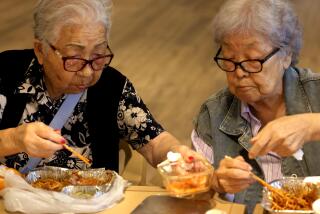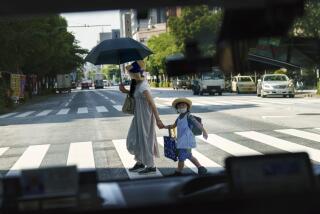Caring for Elderly : Japan Faces an Age-Old Dilemma
- Share via
TOKYO — From the two-room apartment she shares with three other elderly women at the Itabashi Lodging Home, Shima Kobayashi has the leisure to contemplate the changes that she has witnessed in Japanese life during her 86 years.
One room holds four identical beds for the residents of this publicly financed apartment. The second, where Kobayashi holds court kneeling on a brocaded pillow, has tatami mats on the floor and is furnished with a television, a low table supporting a tea set, and prints on the walls.
After identifying herself a bit smugly as an Edokko-- the word, derived from an old name for the city, means a Tokyo native--she smoothed her dignified gray kimono and said that of her six children, four are still living. Every three months, they and their families come to visit her.
‘Different Worlds’
“When I was raising my children, I thought one of them would take care of me,” she said. “In the old days, it was believed that we had to live all together. But even then, that was a past practice. Today the old and the young people live in different worlds.”
The relationship between those worlds is likely to become Japan’s paramount social concern for the rest of this century and beyond. For the Japanese population is aging to a greater extent, and more rapidly, than any other nation known to man.
Between the years 1990 and 2000, the percentage of the population that is 65 and older will increase from just over 10% to more than 15%. By 2020 it will be closer to 25%. By 2010 it will have outstripped the corresponding percentage in most other industrialized countries with relatively aged societies, including the United States, France, West Germany and Sweden.
Even more important is the speed of the change. The over-65 population in France moved from 7% to 14% of the general population over a span of 115 years ending in 1980. In Sweden, the shift took 85 years, and in the United States it will take 75 years (through the year 2020).
In Japan, it will happen in only 25 years, scarcely a single generation, requiring heroic adjustments in government and industrial policies as well as in cultural priorities.
Shortage of Beds
In today’s Japan, there is already a severe shortage of nursing-home beds, an overload of geriatric patients in general hospitals, and signs of inadequacy in medical practices and routines to handle the changing profile of patients.
“We must be aware that the exceptionally irregular age structure of the population has never been experienced in the history of mankind,” Toshio Kuroda, Japan’s pre-eminent demographer, wrote late last year. “The future aging process will necessarily bring about unpredictable economic, social, and political problems. . . . It is really a new society.”
Japan traces its tradition of respecting the elderly back to Confucius, whose teachings provide an example of Chinese influence on Japanese culture. But there are many here who believe that the onset of a geriatric society will turn the ideal into more of a myth.
“In Japan, there is a discrepancy between the value of honoring old people and the reality,” said Takako Sodei, a professor of sociology at Ochanomizu University in Tokyo.
Akira Koizumi, chairman of the department of public health at Showa Medical Institute, a prominent private medical college on the outskirts of Tokyo, said: “When I was a young child, before the war, we had very few old people and they were healthy, so we respected them. When I get elderly, I cannot imagine what conditions will be like.”
Ideal on the Decline
The ideal of venerating the elderly has reflected reality less and less in postwar Japan.
First, came Gen. Douglas MacArthur, whose occupation government scrapped the Japanese civil code. The Japanese code had set out the principle that the eldest son’s first priority is the care of elderly parents, and it gave the eldest son the right of accession to all the family’s property to help finance the burden. The occupation-era code reflected the more American practice of giving care of the nuclear family--that is, younger children--the priority.
Over the years, the relative number of three-generation households--children, parents and grandparents--has steadily declined, in part because Japan’s heavy industrialization provoked a migration of young workers to urban areas, leaving older people in rural districts. Multigenerational households have decreased to about 70% of the total from more than 80% in 1960, and demographers expect the percentage to level off at about 50%. The U.S. figure is about 16%.
The Japanese response to the aging trend has occasionally been fanciful. Last year, government bureaucrats proposed the creation of a string of overseas “silver towns,” or settlements of Japanese elderly, in such locales as Canada and Brazil--turning the aged into another Japanese export, like cars and stereos.
Few Japanese took to the proposal, which came from the Ministry of International Trade and Industry and raised the hackles of the Ministry of Health and Welfare.
“It was not a very good proposal,” said Daisaku Maeda, chairman of the department of sociology at the Tokyo Metropolitan Institute of Gerontology. For one thing, he said, “older Japanese would resist going so far because they would not have access to Japanese doctors.”
Popular Topic
Still, the population’s aging is already the backdrop to popular discussion of almost every other topic. It has not been lost on industrial leaders that older workers generally turn out less on a production line than younger workers, that they require more health care, and represent a heavy pension expense.
However, the Japanese trend of older people remaining in the work force longer than those in the United States, and of the formal retirement age steadily creeping up, will almost certainly continue, experts here say. Meanwhile, Japan’s industrial competitors, among them South Korea, will have much younger and theoretically more productive work forces.
From the government standpoint, Japan faces a funding crisis in its social security system akin to that experienced in the United States in the last few years. The requirements of retired people outstripped the money being paid into the system by younger, producing workers.
In Japan the so-called “dependency ratio,” the share of the population younger than 15 and older than 65, will similarly reach world-record levels over the next 20 years. By the year 2010, about 56% of the population will be dependent on the other 44%.
The cause of this country’s demographic aging is an unusual combination of a sharply dropping birth rate since the last genuine baby boom, in the early and mid-1950s, and a life expectancy level higher than that of any other country surveyed by U.N. demographers.
U.N. statistics indicate that the Japanese life expectancy at birth in 1985 was nearly 75 years for men and 80.5 years for women. In 1936, the figure was 47 years for men and 49 for women. Life expectancy for white Americans today is 71.8 years for men and 78.8 years for women.
Low-Fat Diet
Many experts attribute the longevity to the Japanese diet, which is high in fiber and fish protein and remarkably low in animal fats, such as that in beef. The quality of the diet, however, is fast deteriorating, partly because of younger people’s attraction to American fast-food places.
The most immediate impact of the trend has been on health spending, which rises geometrically with an increase in life expectancy. In 1959, when life expectancy was about 65, per capita medical expenditure in Japan was less than 10,000 yen, or about $83 at today’s prevailing exchange rates. The per capita expenditure today is 110,000 yen, or $916.
Much of this money goes to care for elderly people, who have a complex of medical problems different from those in the United States and European countries, where Alzheimer’s disease appears to be a chief geriatric concern.
In Japan, doctors say Alzheimer’s is a relatively small problem. They classify many more elderly into a general category of “demented,” a condition of impaired mental and physical function traced to hypertension and other cardiovascular conditions. Only recently has the medical establishment here begun to regard dementia as a treatable condition.
“In the past, we were led to think that it was natural for people to become confused as they got old,” says Mie M. Ohwa, a research associate at the Tokyo Metropolitan Institute of Gerontology.
Many social welfare professionals also believe that the unique psychological needs of sick older persons are ill-served by Japan’s notoriously imperious doctors, who traditionally brook no questions from patients and almost never make the effort to explain an ailment or describe a course of treatment.
‘Doctor Is a God’
“At the hospital, the doctor is a god,” Sodei, the professor of sociology, said. “In Japan, the level of medical technology is quite high, but there are no philosophical or ethical courses at the medical schools.”
Koizumi of the Showa Medical Institute said, “Health professionals should be concerned with the social and cultural aspects of health, but our traditional medical education does not consider the human being, just the disease.”
The burden of caring for ailing old people still falls heaviest on the family. It creates the greatest social problems in places such as Tokyo, where living space is at a premium, where middle-aged and younger people are preoccupied with work and the elderly face the greatest neglect and isolation. In this environment, the conflict between intergenerational responsibilities can be impossible to resolve.
At the Tokyo Metropolitan Geriatric Center, social worker Fumiko Yasuoka displays a suite constructed several years ago to enable families to learn first-hand how to care for the ailing elderly. The idea was for them to live for several days in the suite, which is equipped with conventional beds, furniture and kitchen appliances, while staff members demonstrated how to feed and bathe and relate psychologically to older relatives. The program was a failure.
“We couldn’t find any enthusiastic family members,” Yasuoka said. “Older relatives might move in, but their family members were too busy to come here and and stay together with them to get training.”
Similarly, the institute’s unique halfway house, where it prepares 20 elderly persons at a time to move out of nursing homes and back in with their families or into their own apartments, has had limited success.
‘They Just Give Up’
“Many of those who come home simply come back into long-term care here,” she said. “They would like to live with their families, but they just give up. In fact, if the patient’s condition is getting worse, it’s questionable whether living together is really the best thing for both sides.”
To the extent that the elderly are living with their families, the household strain falls disproportionately on women.
“Care of the elderly is a women’s issue here,” Sodei said. Although women are just beginning to infiltrate the long-term work force in significant numbers, she said, “many women now have to stop working, not to care for children but for old parents.”
With a Ministry of Labor advisory group, Sodei is investigating the prospect of creating a system of leaves of absence for workers to care for family elderly.
“It’s very difficult,” she acknowledged. “You can foresee how long a leave should be to care for a child, but with the elderly it’s very different. They might die in a month, or 10 years.”
Moreover, those who care for their aged parents increasingly are older people themselves. Government surveys indicate that as many as 25% of the family caretakers of elderly people are over 60, and 3% are 80 or older.
Meanwhile, Japan faces a shortage of nursing care. The number of beds in all geriatric institutions more than doubled, to 191,000, between 1970 and 1983. But the proportion of institutionalized elderly scarcely budged; of the nation’s half-million bedridden elderly in 1984, about 326,000 were being cared for at home by their children.
Medical Standard-Setters
Still, of Japan’s nursing homes and other geriatric institutions, some are global standard setters. One is operated by Tokyo Yurinkai, a private but government-subsidized social welfare foundation in the affluent Tokyo suburb of Setagaya.
Presided over by Chairwoman Kaoru Ishii, whose late husband established the foundation as a hospital for tubercular orphans, Yurinkai three years ago opened a spotless three-story home for 80 long-term patients. On the waiting list are 200 patients, many of whom are bedridden in general hospitals.
This kind of facility is rare. The high price of land makes it almost impossible to find another adequate, affordable building site anywhere near Tokyo, even for a government agency.
Because her institute owned the only available land in the district, Ishii managed to get the Setagaya district government to pay much of the cost of the new building, $8.3 million, by agreeing to incorporate a facility where local families can leave aged relatives for short periods so they themselves can handle other family crises, have acute problems treated or simply take a rest from the strain of multigenerational living.
Most geriatric institutions must be built in rural areas, where space is available, but at the expense of the patients’ enforced isolation from their families.
More to Read
Sign up for Essential California
The most important California stories and recommendations in your inbox every morning.
You may occasionally receive promotional content from the Los Angeles Times.













